Analyzing the Global Coffee Supply Chain: A Business Report
VerifiedAdded on 2021/04/17
|7
|1316
|57
Report
AI Summary
This report provides a comprehensive analysis of the coffee supply chain, detailing the roles of producers, distributors, retailers, and customers. It examines the key entities involved, including coffee growers, intermediaries, exporters, importers, and retailers, and their functions within the supply chain. The report highlights the importance of effective relationship management between these entities, emphasizing the need for quality control, timely delivery, and customer satisfaction. It discusses the challenges of the coffee supply chain, such as communication breakdowns, pricing disagreements, distribution costs, and the impact of intermediaries on producers. The analysis underscores the complexity of the coffee supply chain and the need for collaboration to ensure a smooth flow of the product from origin to consumer. The report concludes by emphasizing the importance of understanding these relationships to optimize the process.
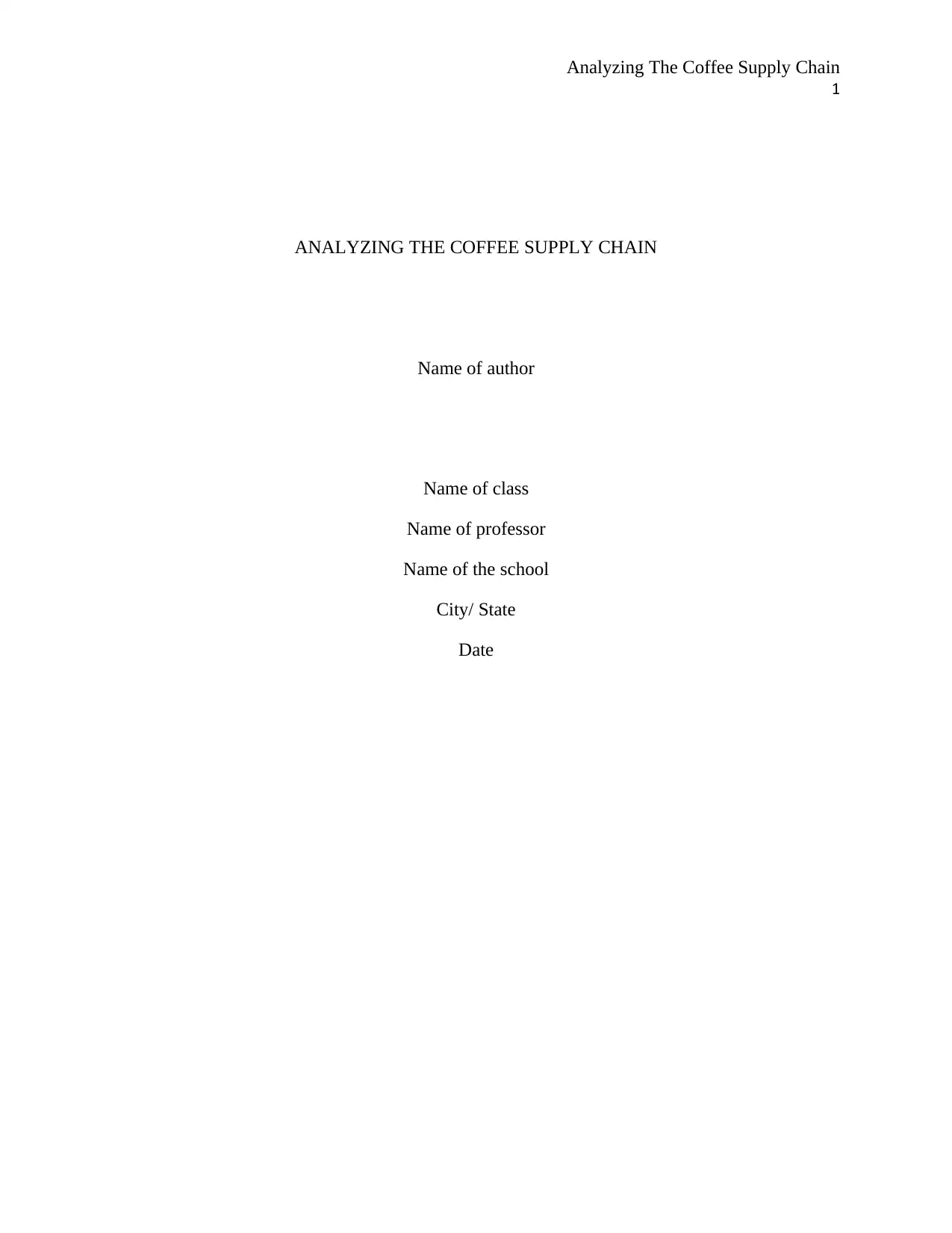
Analyzing The Coffee Supply Chain
1
ANALYZING THE COFFEE SUPPLY CHAIN
Name of author
Name of class
Name of professor
Name of the school
City/ State
Date
1
ANALYZING THE COFFEE SUPPLY CHAIN
Name of author
Name of class
Name of professor
Name of the school
City/ State
Date
Paraphrase This Document
Need a fresh take? Get an instant paraphrase of this document with our AI Paraphraser
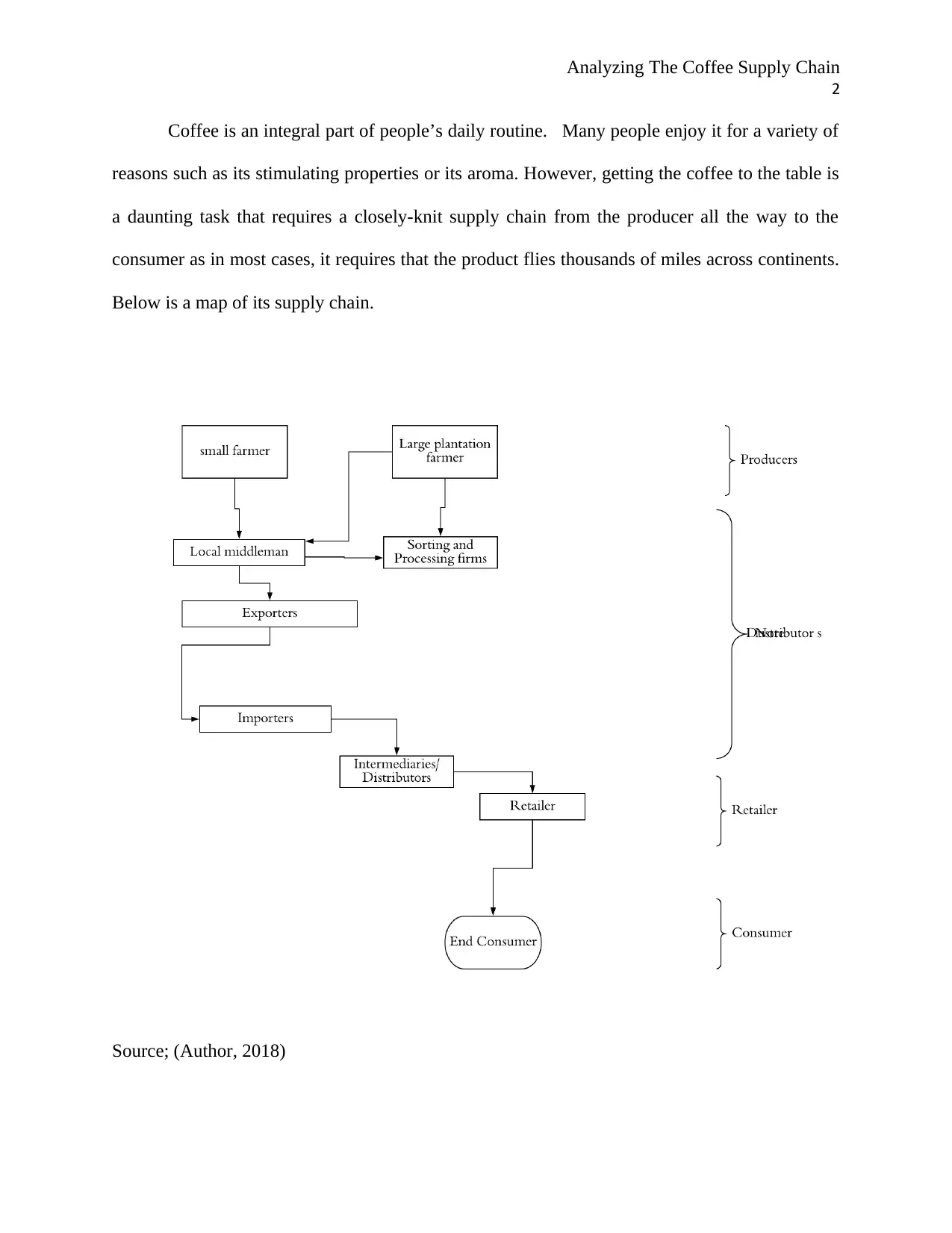
Analyzing The Coffee Supply Chain
2
Coffee is an integral part of people’s daily routine. Many people enjoy it for a variety of
reasons such as its stimulating properties or its aroma. However, getting the coffee to the table is
a daunting task that requires a closely-knit supply chain from the producer all the way to the
consumer as in most cases, it requires that the product flies thousands of miles across continents.
Below is a map of its supply chain.
Source; (Author, 2018)
2
Coffee is an integral part of people’s daily routine. Many people enjoy it for a variety of
reasons such as its stimulating properties or its aroma. However, getting the coffee to the table is
a daunting task that requires a closely-knit supply chain from the producer all the way to the
consumer as in most cases, it requires that the product flies thousands of miles across continents.
Below is a map of its supply chain.
Source; (Author, 2018)
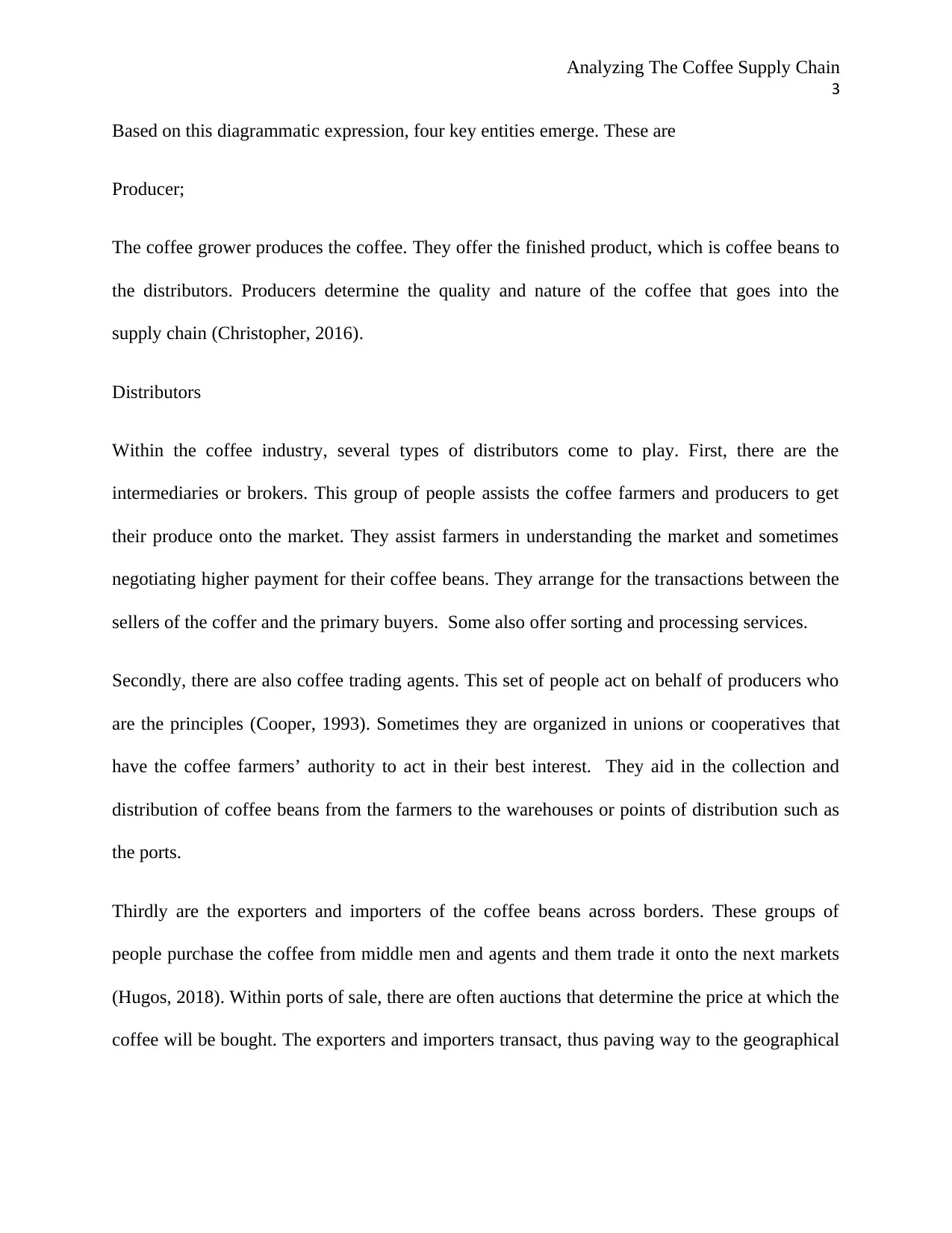
Analyzing The Coffee Supply Chain
3
Based on this diagrammatic expression, four key entities emerge. These are
Producer;
The coffee grower produces the coffee. They offer the finished product, which is coffee beans to
the distributors. Producers determine the quality and nature of the coffee that goes into the
supply chain (Christopher, 2016).
Distributors
Within the coffee industry, several types of distributors come to play. First, there are the
intermediaries or brokers. This group of people assists the coffee farmers and producers to get
their produce onto the market. They assist farmers in understanding the market and sometimes
negotiating higher payment for their coffee beans. They arrange for the transactions between the
sellers of the coffer and the primary buyers. Some also offer sorting and processing services.
Secondly, there are also coffee trading agents. This set of people act on behalf of producers who
are the principles (Cooper, 1993). Sometimes they are organized in unions or cooperatives that
have the coffee farmers’ authority to act in their best interest. They aid in the collection and
distribution of coffee beans from the farmers to the warehouses or points of distribution such as
the ports.
Thirdly are the exporters and importers of the coffee beans across borders. These groups of
people purchase the coffee from middle men and agents and them trade it onto the next markets
(Hugos, 2018). Within ports of sale, there are often auctions that determine the price at which the
coffee will be bought. The exporters and importers transact, thus paving way to the geographical
3
Based on this diagrammatic expression, four key entities emerge. These are
Producer;
The coffee grower produces the coffee. They offer the finished product, which is coffee beans to
the distributors. Producers determine the quality and nature of the coffee that goes into the
supply chain (Christopher, 2016).
Distributors
Within the coffee industry, several types of distributors come to play. First, there are the
intermediaries or brokers. This group of people assists the coffee farmers and producers to get
their produce onto the market. They assist farmers in understanding the market and sometimes
negotiating higher payment for their coffee beans. They arrange for the transactions between the
sellers of the coffer and the primary buyers. Some also offer sorting and processing services.
Secondly, there are also coffee trading agents. This set of people act on behalf of producers who
are the principles (Cooper, 1993). Sometimes they are organized in unions or cooperatives that
have the coffee farmers’ authority to act in their best interest. They aid in the collection and
distribution of coffee beans from the farmers to the warehouses or points of distribution such as
the ports.
Thirdly are the exporters and importers of the coffee beans across borders. These groups of
people purchase the coffee from middle men and agents and them trade it onto the next markets
(Hugos, 2018). Within ports of sale, there are often auctions that determine the price at which the
coffee will be bought. The exporters and importers transact, thus paving way to the geographical
⊘ This is a preview!⊘
Do you want full access?
Subscribe today to unlock all pages.

Trusted by 1+ million students worldwide
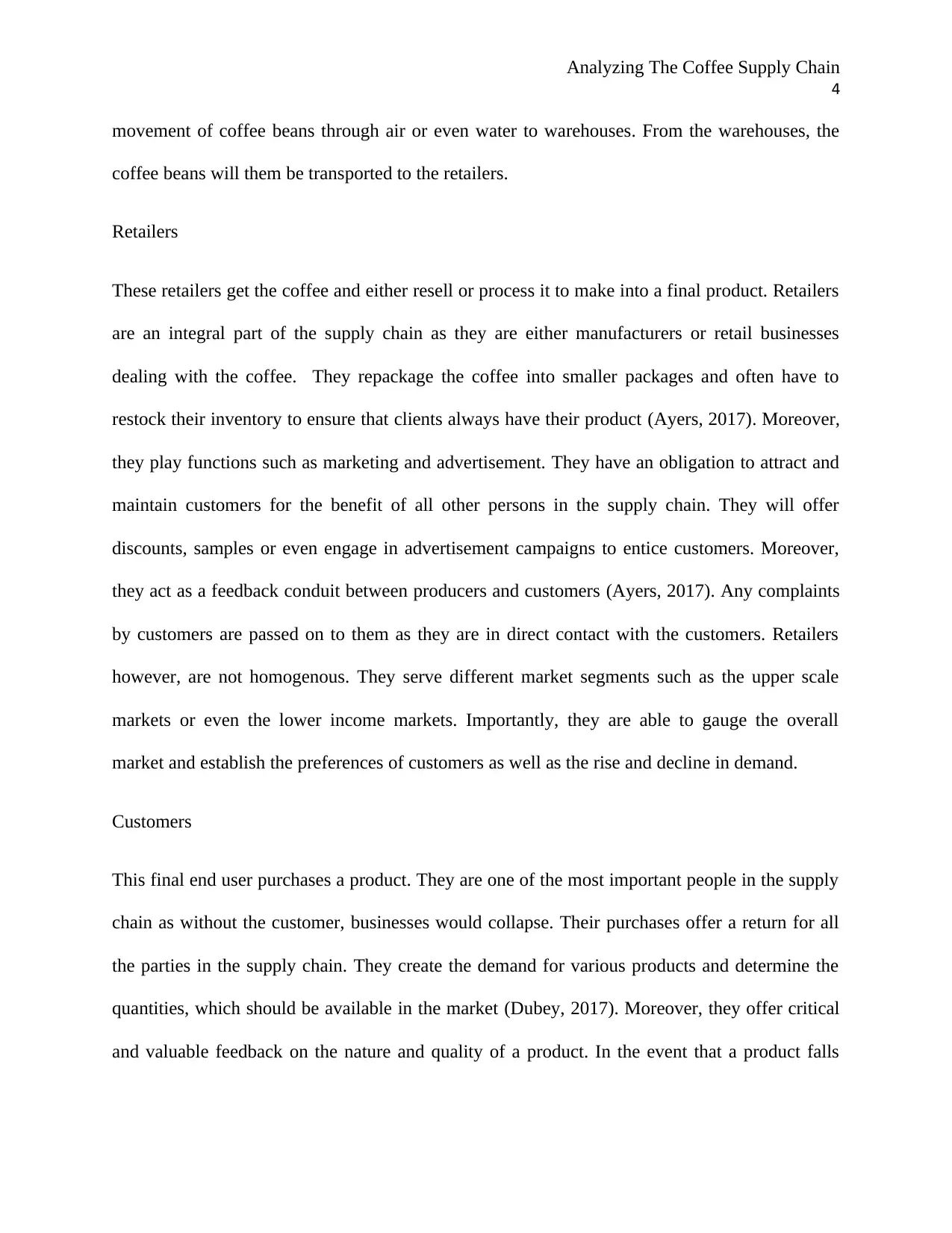
Analyzing The Coffee Supply Chain
4
movement of coffee beans through air or even water to warehouses. From the warehouses, the
coffee beans will them be transported to the retailers.
Retailers
These retailers get the coffee and either resell or process it to make into a final product. Retailers
are an integral part of the supply chain as they are either manufacturers or retail businesses
dealing with the coffee. They repackage the coffee into smaller packages and often have to
restock their inventory to ensure that clients always have their product (Ayers, 2017). Moreover,
they play functions such as marketing and advertisement. They have an obligation to attract and
maintain customers for the benefit of all other persons in the supply chain. They will offer
discounts, samples or even engage in advertisement campaigns to entice customers. Moreover,
they act as a feedback conduit between producers and customers (Ayers, 2017). Any complaints
by customers are passed on to them as they are in direct contact with the customers. Retailers
however, are not homogenous. They serve different market segments such as the upper scale
markets or even the lower income markets. Importantly, they are able to gauge the overall
market and establish the preferences of customers as well as the rise and decline in demand.
Customers
This final end user purchases a product. They are one of the most important people in the supply
chain as without the customer, businesses would collapse. Their purchases offer a return for all
the parties in the supply chain. They create the demand for various products and determine the
quantities, which should be available in the market (Dubey, 2017). Moreover, they offer critical
and valuable feedback on the nature and quality of a product. In the event that a product falls
4
movement of coffee beans through air or even water to warehouses. From the warehouses, the
coffee beans will them be transported to the retailers.
Retailers
These retailers get the coffee and either resell or process it to make into a final product. Retailers
are an integral part of the supply chain as they are either manufacturers or retail businesses
dealing with the coffee. They repackage the coffee into smaller packages and often have to
restock their inventory to ensure that clients always have their product (Ayers, 2017). Moreover,
they play functions such as marketing and advertisement. They have an obligation to attract and
maintain customers for the benefit of all other persons in the supply chain. They will offer
discounts, samples or even engage in advertisement campaigns to entice customers. Moreover,
they act as a feedback conduit between producers and customers (Ayers, 2017). Any complaints
by customers are passed on to them as they are in direct contact with the customers. Retailers
however, are not homogenous. They serve different market segments such as the upper scale
markets or even the lower income markets. Importantly, they are able to gauge the overall
market and establish the preferences of customers as well as the rise and decline in demand.
Customers
This final end user purchases a product. They are one of the most important people in the supply
chain as without the customer, businesses would collapse. Their purchases offer a return for all
the parties in the supply chain. They create the demand for various products and determine the
quantities, which should be available in the market (Dubey, 2017). Moreover, they offer critical
and valuable feedback on the nature and quality of a product. In the event that a product falls
Paraphrase This Document
Need a fresh take? Get an instant paraphrase of this document with our AI Paraphraser
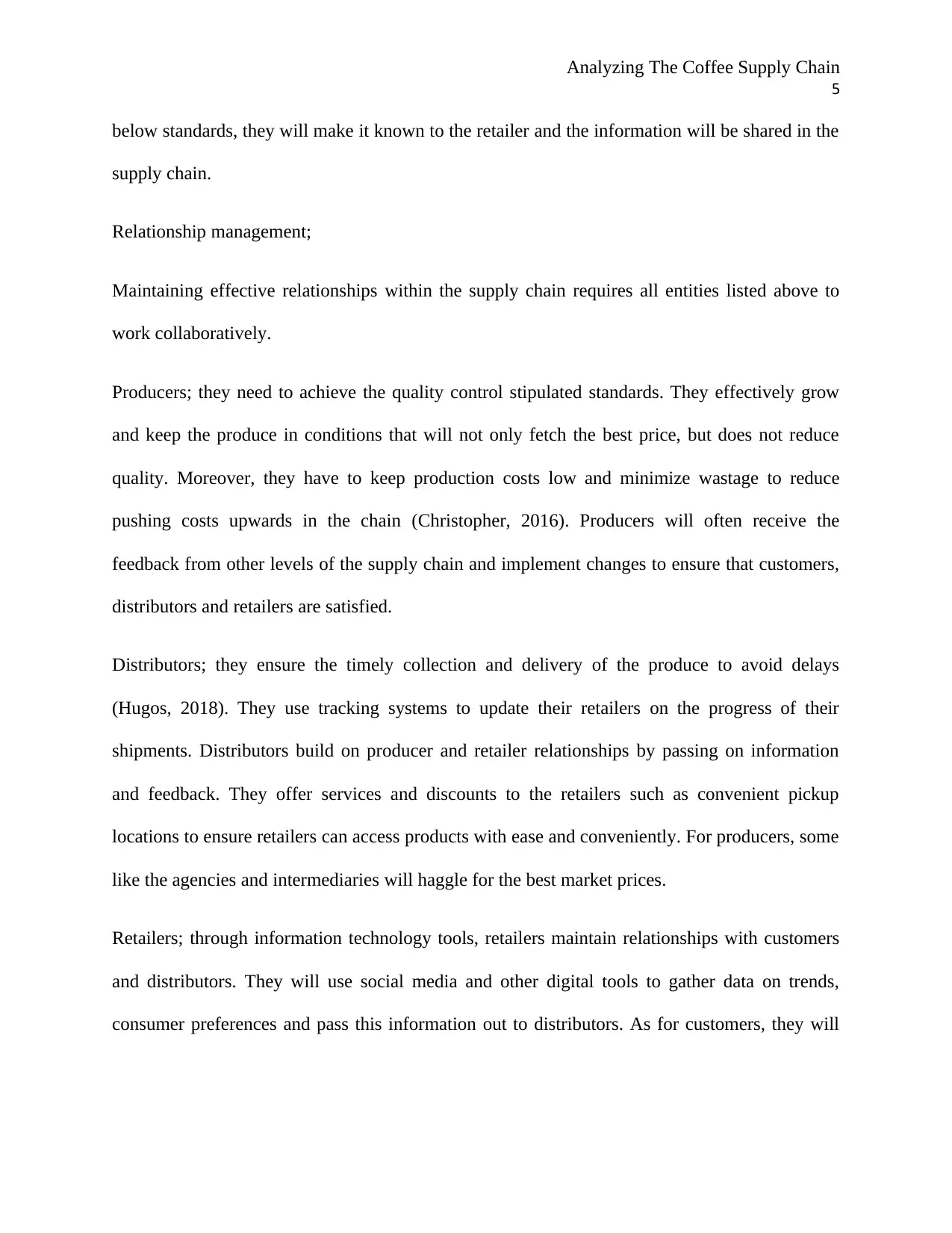
Analyzing The Coffee Supply Chain
5
below standards, they will make it known to the retailer and the information will be shared in the
supply chain.
Relationship management;
Maintaining effective relationships within the supply chain requires all entities listed above to
work collaboratively.
Producers; they need to achieve the quality control stipulated standards. They effectively grow
and keep the produce in conditions that will not only fetch the best price, but does not reduce
quality. Moreover, they have to keep production costs low and minimize wastage to reduce
pushing costs upwards in the chain (Christopher, 2016). Producers will often receive the
feedback from other levels of the supply chain and implement changes to ensure that customers,
distributors and retailers are satisfied.
Distributors; they ensure the timely collection and delivery of the produce to avoid delays
(Hugos, 2018). They use tracking systems to update their retailers on the progress of their
shipments. Distributors build on producer and retailer relationships by passing on information
and feedback. They offer services and discounts to the retailers such as convenient pickup
locations to ensure retailers can access products with ease and conveniently. For producers, some
like the agencies and intermediaries will haggle for the best market prices.
Retailers; through information technology tools, retailers maintain relationships with customers
and distributors. They will use social media and other digital tools to gather data on trends,
consumer preferences and pass this information out to distributors. As for customers, they will
5
below standards, they will make it known to the retailer and the information will be shared in the
supply chain.
Relationship management;
Maintaining effective relationships within the supply chain requires all entities listed above to
work collaboratively.
Producers; they need to achieve the quality control stipulated standards. They effectively grow
and keep the produce in conditions that will not only fetch the best price, but does not reduce
quality. Moreover, they have to keep production costs low and minimize wastage to reduce
pushing costs upwards in the chain (Christopher, 2016). Producers will often receive the
feedback from other levels of the supply chain and implement changes to ensure that customers,
distributors and retailers are satisfied.
Distributors; they ensure the timely collection and delivery of the produce to avoid delays
(Hugos, 2018). They use tracking systems to update their retailers on the progress of their
shipments. Distributors build on producer and retailer relationships by passing on information
and feedback. They offer services and discounts to the retailers such as convenient pickup
locations to ensure retailers can access products with ease and conveniently. For producers, some
like the agencies and intermediaries will haggle for the best market prices.
Retailers; through information technology tools, retailers maintain relationships with customers
and distributors. They will use social media and other digital tools to gather data on trends,
consumer preferences and pass this information out to distributors. As for customers, they will
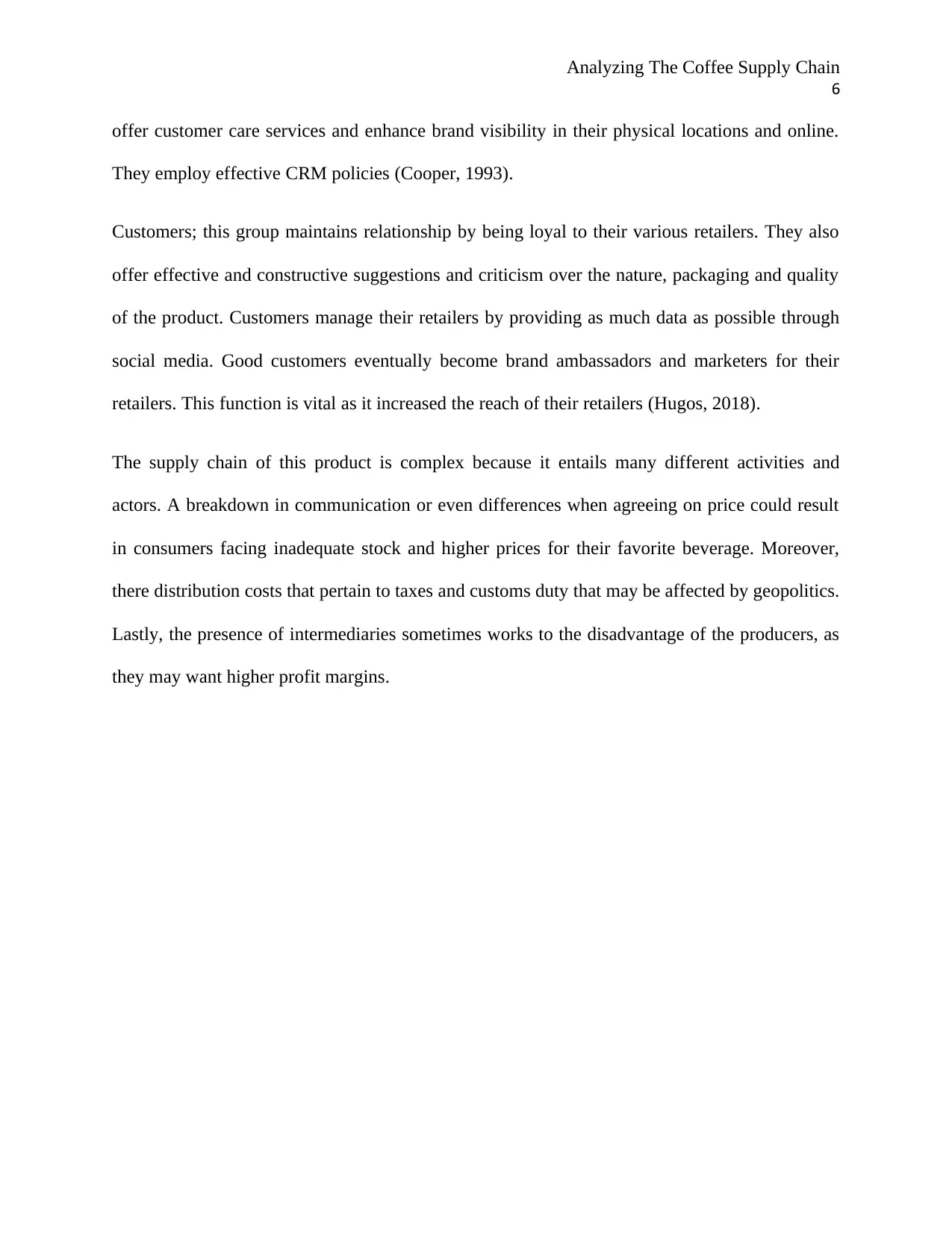
Analyzing The Coffee Supply Chain
6
offer customer care services and enhance brand visibility in their physical locations and online.
They employ effective CRM policies (Cooper, 1993).
Customers; this group maintains relationship by being loyal to their various retailers. They also
offer effective and constructive suggestions and criticism over the nature, packaging and quality
of the product. Customers manage their retailers by providing as much data as possible through
social media. Good customers eventually become brand ambassadors and marketers for their
retailers. This function is vital as it increased the reach of their retailers (Hugos, 2018).
The supply chain of this product is complex because it entails many different activities and
actors. A breakdown in communication or even differences when agreeing on price could result
in consumers facing inadequate stock and higher prices for their favorite beverage. Moreover,
there distribution costs that pertain to taxes and customs duty that may be affected by geopolitics.
Lastly, the presence of intermediaries sometimes works to the disadvantage of the producers, as
they may want higher profit margins.
6
offer customer care services and enhance brand visibility in their physical locations and online.
They employ effective CRM policies (Cooper, 1993).
Customers; this group maintains relationship by being loyal to their various retailers. They also
offer effective and constructive suggestions and criticism over the nature, packaging and quality
of the product. Customers manage their retailers by providing as much data as possible through
social media. Good customers eventually become brand ambassadors and marketers for their
retailers. This function is vital as it increased the reach of their retailers (Hugos, 2018).
The supply chain of this product is complex because it entails many different activities and
actors. A breakdown in communication or even differences when agreeing on price could result
in consumers facing inadequate stock and higher prices for their favorite beverage. Moreover,
there distribution costs that pertain to taxes and customs duty that may be affected by geopolitics.
Lastly, the presence of intermediaries sometimes works to the disadvantage of the producers, as
they may want higher profit margins.
⊘ This is a preview!⊘
Do you want full access?
Subscribe today to unlock all pages.

Trusted by 1+ million students worldwide
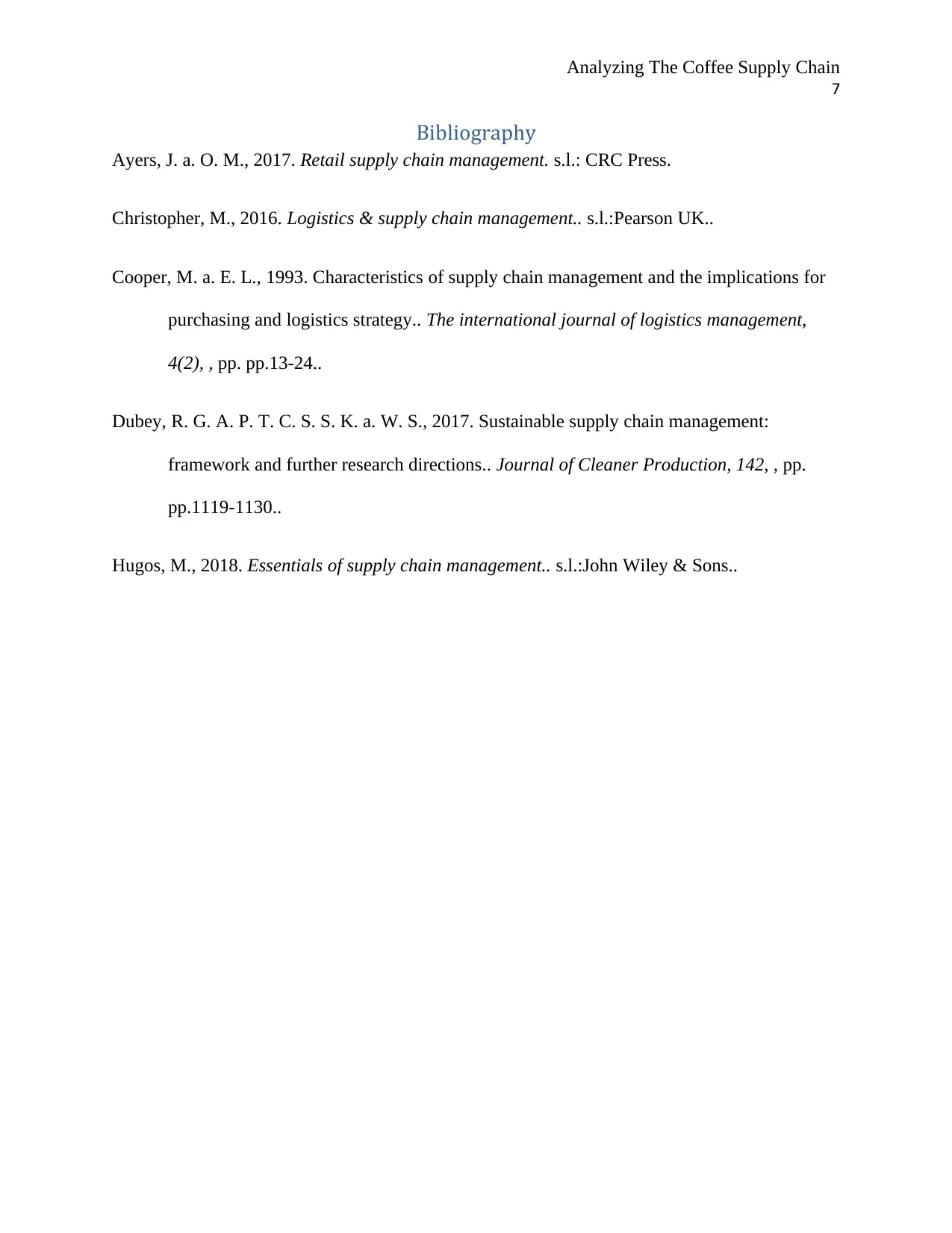
Analyzing The Coffee Supply Chain
7
Bibliography
Ayers, J. a. O. M., 2017. Retail supply chain management. s.l.: CRC Press.
Christopher, M., 2016. Logistics & supply chain management.. s.l.:Pearson UK..
Cooper, M. a. E. L., 1993. Characteristics of supply chain management and the implications for
purchasing and logistics strategy.. The international journal of logistics management,
4(2), , pp. pp.13-24..
Dubey, R. G. A. P. T. C. S. S. K. a. W. S., 2017. Sustainable supply chain management:
framework and further research directions.. Journal of Cleaner Production, 142, , pp.
pp.1119-1130..
Hugos, M., 2018. Essentials of supply chain management.. s.l.:John Wiley & Sons..
7
Bibliography
Ayers, J. a. O. M., 2017. Retail supply chain management. s.l.: CRC Press.
Christopher, M., 2016. Logistics & supply chain management.. s.l.:Pearson UK..
Cooper, M. a. E. L., 1993. Characteristics of supply chain management and the implications for
purchasing and logistics strategy.. The international journal of logistics management,
4(2), , pp. pp.13-24..
Dubey, R. G. A. P. T. C. S. S. K. a. W. S., 2017. Sustainable supply chain management:
framework and further research directions.. Journal of Cleaner Production, 142, , pp.
pp.1119-1130..
Hugos, M., 2018. Essentials of supply chain management.. s.l.:John Wiley & Sons..
1 out of 7
Your All-in-One AI-Powered Toolkit for Academic Success.
+13062052269
info@desklib.com
Available 24*7 on WhatsApp / Email
![[object Object]](/_next/static/media/star-bottom.7253800d.svg)
Unlock your academic potential
Copyright © 2020–2025 A2Z Services. All Rights Reserved. Developed and managed by ZUCOL.


